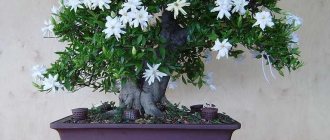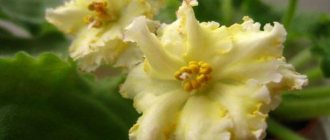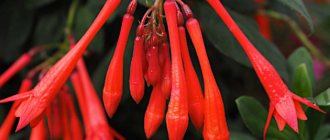Rosa Cordana mix is a line of varieties of miniature shrubs from the Rosaceae family and the Rosaceae subfamily. They love to plant it in homes and gardens for its attractive lushness and abundant flowering. But caring for a Cordana rose is quite difficult.
To ensure that the plant does not die quickly and is able to take root, it is very important to provide it with proper care immediately after the store. Many people make mistakes that can lead to a rapid loss of attractiveness and death of the rose. Therefore, before you get this beauty, you need to thoroughly prepare. Provide all conditions that will allow it to fully bloom and develop.
Detailed description of the potted plant "Kardana"
Rose Cordana refers to a line of different varieties of miniature roses. They are characterized by a long flowering period and a wide variety of flower colors.
Rosa Cordana grows in bushes, albeit small ones . Castes are found as narrow pyramidal, crayfish and spreading. The plant can reach a height of 35 cm. Flowers are formed singly or in inflorescences, depending on the variety of rose. The flowers have a classic shape and color from white, cream, pink, yellow to red and purple.
History of origin
For the first time there was a conspiracy about the rose of Cordan in the 19th century.
In 1810, European countries imported dwarf tea roses from China. Flower growers really liked these varieties, they were especially impressed by their size. A little later, breeders began crossing dwarf tea roses with other varieties of plants of this genus. Miniature roses received the name Cardana in honor of the flower breeder who was involved in their breeding, Wilhelm Cordes.
Varieties of indoor plants in a pot
There are several subvarieties among Cordana roses. The most popular of them are described below.
Mini
The most popular is the Mini Caliber . It forms small flowers reaching a diameter of 3 cm. The petals are painted in a bright orange-red color. Blooms profusely until frost.
Mix
The Cordana Mix variety is considered the most famous and sought after. The plant produces a large number of flowers. It is resistant to bad weather, but does not like excess light and water. Flowering lasts about six months.
You can learn more about the varieties of the lovely mixed rose and the features of its cultivation here.
The best
The best varieties of flowers include:
- Pearl . Characterized by creamy white flowers. The flowers are goblet-shaped.
- Ballet . So named because the fully opened flower looks very much like a tutu and is a deep, hot pink color.
- Magnolia . Produces single flowers of creamy pink color. The outer petals are colored soft green.
- Pasadena . It is considered a classic rose variety, but in miniature. It blooms with red flowers, produces a large number of petals, and is disease resistant.
Winter-hardy
Despite the fact that the Cordana rose does not tolerate low temperatures very well, there are varieties that have good winter hardiness:
- Impala . It blooms with delicate apricot flowers and is resistant to both bad weather and many diseases.
- Kiss . It produces single flowers and blooms cherry-red.
Additional Tips
Spraying bushes with water should be treated with caution; use only clean, settled water, or even boiled water. This is done in order to cool the plant or save it from dry air, then it is better to carry out the event in the evening, but not too often.
When transplanting a plant from a container or from an old pot to a new one, you need to take a container 5 cm wider and the same amount higher than the previous one. By the way, before using a new clay pot, you should soak it in water for several hours, and only then add soil.
Rose loves a room with fresh air; it would be nice to provide her with constant air circulation, but so that she does not end up in drafts. Daylight should last about 12 hours so that the rose does not stop blooming, so you should provide a fluorescent lamp next to it that will highlight the missing hours.
It is better to carry out all transplants when the moon is waxing, and to fight pests and diseases, if any are found, on the waning moon. All parts of the plant affected by disease must be pruned and destroyed. It is advisable not to forget to remove fading buds, this stimulates the formation of new ones.
Bloom
Flowering is an important period in the growing season of a plant, requiring special attention. It is important to properly care for your rose in order to achieve lush and beautiful flowering.
When and how does it bloom?
Cordana blooms in October-May . The duration of this period may vary depending on the correct care. Flowering can be achieved even in winter, but this will require creating special conditions to simulate the climate of the summer season.
Care before and after buds appear: features
You need to care for a rose throughout its life, regardless of the phase of growth and development.
The only feature of care after flowering of the Cordana rose is the need for careful pruning.
When flowering ends, you need to trim all the flowers and inflorescences of the plant.
What to do if there are no buds?
If the Cordana rose does not want to bloom, then the reason may be either improper care or the presence of some disease or pest. To understand why Rosa Cordana does not bloom, you need to examine the flower and find out the reason.
To resume the normal cycle of growth and development of the plant, it will be necessary to eliminate the factor causing harm.
Conditions for growth
As already mentioned, Rose Cordana is a capricious and difficult plant to care for, which means it requires special conditions for full and proper growth. It is necessary to follow all the instructions of specialists so that the flower does not get sick and delights its owner with beautiful flowers throughout the summer. So, for growth you need the following:
- Enough light. Like all roses, this variety requires a lot of sunlight. It is best to place the flower pot on a windowsill that is sufficiently lit throughout the day and faces south. If the windows face north or the climate is not warm enough, you can purchase fluorescent lamps with ultraviolet light, which will be very useful not only for Roses, but also for other plants.
- Comfortable temperature. Experts believe that for proper plant growth, the temperature should not fall below 15 degrees Celsius and rise above 19 degrees.
- Fresh air. The development of roses is beneficially affected by a sufficient amount of fresh air in the room, so it should be regularly ventilated. The main thing is to make sure that it is not blown by a cold wind - drafts can negatively affect the development of Rose.
Rosa Cordana feels great in a pot at home
- Humidity. For proper growth of roses, a high level of indoor humidity is necessary. This can be achieved if a humidifier is installed in the room, or simply by regularly spraying the leaves with a spray bottle. It is important that the water is warm and not cold.
- Watering. As with all plants, moderation must be observed here. The roots of the plant should not dry out from lack of liquid, but stagnant water in the pot also negatively affects growth.
Step-by-step instructions: how to care for it at home after purchase?
Caring for a Cordana rose is a labor-intensive and difficult process. If you want to acquire such a flower, you need to study in as much detail as possible all the nuances of caring for it. Otherwise, the plant will quickly die.
Selection of capacity
The first thing you need to do after buying a flower is to replant it . To do this you will need to select a suitable container. It is worth purchasing a pot that is 5-7 cm higher in height than the previous one and 2-4 cm in diameter.
If the pot is new or made of ceramic, then pre-soak it in hot water for 2-3 hours. The previously used pot is thoroughly cleaned of soil residues using a stiff brush.
What should the soil be like?
The miniature rose is demanding on the soil. It is recommended to purchase a special composition intended for roses . If you don’t want to make the soil yourself, then you will need to mix turf soil, humus and sand, maintaining a ratio of 4:4:1.
Landing
Growing roses from seeds is a process that is difficult even for experienced plant growers. But those who want to try their luck and grow Cordana rose with seeds should know that the conditions under which the seeds germinate are a temperature of 18 degrees and lighting for 10 hours a day.
An additional measure that promotes seed germination is stratification : placing seed material for several months in low temperature conditions. For this procedure, you will need to place the seeds in a piece of gauze soaked in hydrogen peroxide and place it in the refrigerator for several months.
Periodically, the seeds need to be taken out, ventilated or the gauze cloth changed to avoid rotting of the seeds and the appearance of mold. After stratification, you can sow the Cordana rose in the usual way.
Temperature in winter and other times of the year
The optimal temperature regime at which the rose feels good varies within 15 degrees. The temperature should not be allowed to rise above 22 degrees . In winter, the most comfortable temperature for plants is 5-8 degrees. If it is necessary to artificially put the plant into a state of dormancy, then the temperature is gradually lowered to 10-12 degrees.
Watering
You need to water regularly, but in moderation. The soil should be slightly moist between spills. Only drying of the top layer is allowed. Under no circumstances should you allow excess moisture in the pot, as this will lead to rotting of the roots. You need to water the rose from above, using only warm, settled water. Water should not be allowed to stagnate in the pan.
Top dressing
You should start applying fertilizer only after 3 months have passed from the date of purchase of the plant. It is worth maintaining such a period of time for the reason that applying fertilizers immediately after purchasing a flower leads to the formation of an excess amount of salts in the soil .
The plants are fed in the spring and summer; in the spring they are fertilized with nitrogen-containing fertilizers, in the summer - with potassium-phosphorus fertilizers. You can purchase specialized fertilizer for roses. The frequency of fertilization is once every 7-10 days.
Trimming
Pruning is carried out in the following cases:
- In the spring, diseased, damaged roots are cut off. This is done during transplantation.
- In the summer , flowers that have wilted are cut off.
- In autumn you need to trim flowers and inflorescences. This event has a good effect on the overwintering of the plant.
When pruning, you should leave three or four buds on one branch and remove the rest. It is not recommended to leave shoots that are crooked or too long on the plant.
Transfer
The Cordana rose is replanted immediately after purchase . In the future, the flower needs to be replanted once a year. To transplant you will need to do the following:
- water the soil in the pot generously for easy removal of the plant in the future;
- pour a drainage layer into a new container;
- carefully remove the rose from the pot without disturbing the integrity of the earth;
- place in a new container and fill in the missing amount of soil.
There is no need to water the rose after transplantation , since the excess amount of moisture will be distributed throughout the entire volume of the soil.
Additional Tips
Spraying bushes with water should be treated with caution; use only clean, settled water, or even boiled water. This is done in order to cool the plant or save it from dry air, then it is better to carry out the event in the evening, but not too often.
When transplanting a plant from a container or from an old pot to a new one, you need to take a container 5 cm wider and the same amount higher than the previous one. By the way, before using a new clay pot, you should soak it in water for several hours, and only then add soil.
Rose loves a room with fresh air; it would be nice to provide her with constant air circulation, but so that she does not end up in drafts. Daylight should last about 12 hours so that the rose does not stop blooming, so you should provide a fluorescent lamp next to it that will highlight the missing hours.
It is better to carry out all transplants when the moon is waxing, and to fight pests and diseases, if any are found, on the waning moon. All parts of the plant affected by disease must be pruned and destroyed. It is advisable not to forget to remove fading buds, this stimulates the formation of new ones.
How to propagate?
To propagate the flower, the cutting method is used. The optimal time for reproduction is May-August. Cut the branches, leaving three or four buds on each. The lower cut of the stem is made diagonally, keeping an angle of 45 degrees, the upper one is left straight. Leave the cut stems in water with a small amount of growth stimulant.
Periodically you need to add water and add a growth regulator . Once roots at least 2 cm long appear on the cuttings, they can be transplanted into pots.
Reproduction
Propagating your favorite plant does not require much effort and time. This is best done in the summer, cutting the required number of cuttings 2-3 mm thick from the bush. Their lower cut is made oblique, 3-4 buds are left on the shoot, after which it is placed in a container with water poured 3 cm from the bottom.
To stimulate root formation, add Kornevin or Heteroauxin to the water. As the liquid evaporates, the liquid is added, but not completely changed.
Another method of rooting cuttings is shown in the video:
The roots appear after 3-4 weeks. When they grow to 2 cm, the cuttings are planted in pots with soil and placed in a room with dim lighting for several days. And when they take root, they are transferred to a bright place.
Diseases and pests
Rose Cordana is susceptible to various diseases and pest damage. The main pests on roses are:
- Mealybug . Leaves lumps in appearance resembling cotton wool in the leaf axils.
- Shield . Barely noticeable formations on the stems of the plant.
- Whitefly . The larvae leave behind white leaves.
- Thrips . The appearance of white or gray streaks is observed from the top of the sheet.
- Aphid . It is impossible not to notice the driver.
- Spider mite . A powdery coating appears from the bottom of the leaf, cobwebs are present, and the leaves turn white.
As a preventive measure that will protect the plant from pests, treatment is carried out using an insecticide, for example, Aktaru at the rate of 1 g per 10 liters of water for irrigation, and the foliage is sprayed with a solution of 4 g per 5 liters.
Diseases include:
- Spotting. Black or white spots on leaves.
- Powdery mildew. Appears on the leaves in the form of plaque.
- Gray rot. It looks like gray fluff.
To get rid of diseases, they are treated with fungicides , for example, Hom, Topaz, Skor, Colloidal sulfur.
Despite the fact that caring for and growing Cordana rose at home is quite troublesome, many still choose this plant and for a reason. Beautiful, lush and long flowering cannot but rejoice. If you adhere to the recommended care for the Cordana rose, there will be no problems with the flower.
If roses have difficulty taking root in open ground, you can try growing them in pots, containers and floor vases. We talked about the rules for caring for bush and dwarf roses in a pot in our articles.
Is it possible to plant the Cordana Mix rose in open ground?
Indoor Cordana grows and develops well in open ground; it can be planted in the garden or flowerbed. Experts recommend planting plants that have reached the age of 3 or more years.
Agrotechnics of cultivation
The process of growing Cordana in gardens and flower beds is not much different from caring for it indoors. The plant needs to be provided with certain conditions:
- the location is western or southwestern, with sufficient light, but without direct sunlight, especially in the hot summer months;
- timely watering, while the soil should not dry out;
- spraying foliage in the evening, especially at temperatures above +25 degrees;
- constant loosening of the top layer of soil;
- the soil composition should be nutritious, but not very dense; add peat if necessary;
- in the summer months, it would be a good idea to mulch the soil to prevent overheating of the roots;
Planting in open ground - stagnation of water is unacceptable at any time; if you notice it, you should immediately reduce the number of waterings;
- use of fertilizing several times during the growing season;
- removing weeds as they appear;
- pruning the bush in the fall after flowering to maintain shape and ensure successful growing season for the next season.
The bushes will grow comfortably near other plants, since the roots of the rose are small and require little space. The main thing is a sufficient amount of nutrients in the soil and timely watering.
You may be interested in:
English garden roses: care features, varieties There is no other flower that has received more attention from gardeners for so many centuries than roses.... Read more...
Shelter for the winter
When growing a mini-rose in open ground, you need to prepare it for the winter cold and help the plant survive it. Preparation for frost should consist of several stages:
- Pruning the bush in autumn to a height of 10-15 cm.
- Hilling up the bush with compost.
- Covering with natural materials (spruce branches, sawdust, leaves) or film, plastic bottles.
If it is not possible to transplant the rose into a greenhouse before spring, it is necessary to cover it for the winter, since the flower will not be able to survive a frosty winter without these measures.











